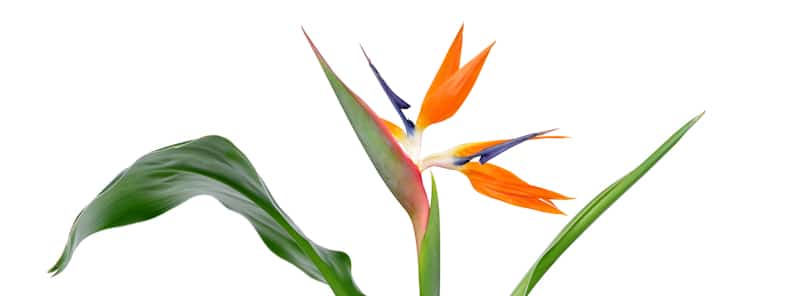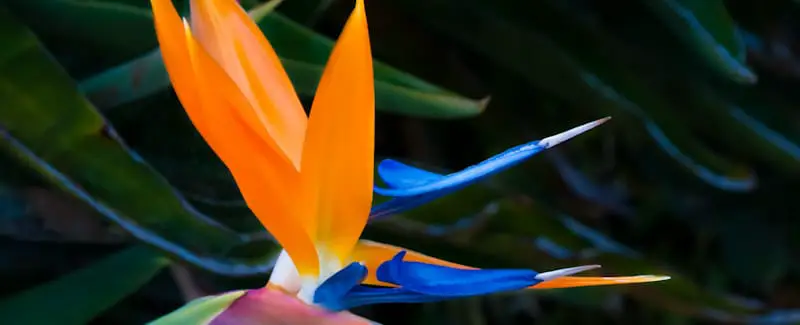The Bird of Paradise is often regarded as the “Queen of the Houseplants.” Its colorful, stunning flowers and shiny, banana-shaped foliage can add a vibrant, tropical touch to any space and elevate the decor! This plant, also referred to as Strelitzia Nicolai, does not bloom indoors but can develop massive leaves when provided with adequate care and maintenance.
Put your Bird of Paradise in a space with lots of sunlight, and water it regularly. Cut down the water during the winter months by switching to intermittent misting. To make your plant thrive indoors, clean its leaves every alternate day and spray mild fertilizer to provide additional nutrients.
Growing a Strelitzia is simple but requires proper care and supervision to flourish. Learn how to take care of these beautiful species with our blog post!

Common Problems With Bird Of Paradise
Providing a tropical-like setting within your home can be a challenge and one that can come in the way of this plant’s growth. If the growing conditions are not correct, they can cause problems in your plant and prevent it from achieving its full potential.
Here are some of the common problems your Bird of Paradise can face.
Root Rot
Are the roots of your plant turning black and mushy? If yes, then it is likely suffering from root rot. Root rot happens because of overwatering. Excess water can turn the soil soggy and hinder oxygen absorption. This also limits nutrient and water absorption and makes the plant vulnerable to pathogen attacks, withering, and probable death.
Curling Leaves
When the plant’s water requirements are not met, its leaves can curl inwards to reduce the surface area and prevent further water loss. Curling of leaves can occur due to underwatering or excessive water loss because of high temperatures and low humidity. Likewise, pests and diseases can also cause the leaves to curl and wither.
Let your plant sit in water for a few hours to replenish the moisture, or use a humidifier to reduce the transpiration rate.
Discoloration Of Leaves
The leaves of a Strelitzia can tell a lot about its condition. Depending on several factors, they can either turn brown or yellow.
Yellow Leaves: A yellow leaf here or there is no concern, but if you start seeing several of them, it is a sign of a watering issue.
A leaf that is only yellow from the center indicates water deficiency and can be treated the same way as the curling leaf problem.
On the other hand, an entirely yellow leaf is an outcome of overwatering, and simply letting the soil dry out will solve this problem. However, if you notice root rot accompanying the excess water, you should repot the plant immediately.
Additionally, yellow leaves can also occur due to nutrient deficiency. These nutrients include iron, nitrogen, phosphorus, magnesium, and zinc. Organic fertilizers like sludge and manure can be used to correct these deficiencies and promote plant health. Iron supplements are also an excellent way to overcome iron depletion.
Brown Edges: If you see the edges of leaves becoming brown and crispy, either the humidity levels are low, or your plant just likes a lot of water. In both cases, water your plant frequently and mist it several times a day to rehydrate it and prevent evaporation.
Leaves Splitting
Many people think that leaf splitting indicates something wrong with their plant, but it is completely normal and nothing to worry about. The splits in the Bird of Paradise are a part of nature’s design and allow wind to flow through the leaves without uprooting or bending the plant. However, if you still want to prevent splitting, you can move your plant indoors or any place with minimal wind exposure.
How To Care For Your Bird Of Paradise?
Now that we have covered the problems of an inadequately looked after Bird of Paradise let’s move on to how to care for it and help it thrive.
Keep It Under Bright, Indirect Light
It is no surprise that these tropical plants require lots of bright light. They can develop large, arching, and graceful leaves when provided with a sufficient amount of light. We advise placing your plant in a setting that provides about 5 to 7 hours of sunlight daily. However, indirect light will be more suitable if the temperatures are very high.
Most Strelitzias can also grow in lower to moderate light, but the plant takes a while to grow and develops smaller leaves in these conditions.
If you plan to shift your plant to the outdoors, acclimate it by putting it under shade for a week and then relocate it under full sunlight.
Provide It With Adequate Water
Since Bird of Paradise requires prolonged exposure to light, its soil can dry out rapidly, and hence needs to be watered frequently. Ideally, you should water this plant regularly, along with a few daily misting sessions. However, do not oversaturate the soil and always remove the excess water through the grow pot. It is advisable to cut down on the water during the fall and winter seasons.
Moreover, water with high salt content can cause the leaves to burn. Therefore, we suggest using rainwater, or more preferably distilled water, for your watering regime.
Choose The Right Soil
A plant’s health is directly related to its soil. Healthy and nutritious soil contains all the required nutrients and moisture to support plant growth. For your Bird of Paradise, choose soil that drains fast and can retain enough water to promote growth.
Put It Under Warm Temperature
This thermophilic plant does not like to be cold and grows best between the temperature of 65-80° Fahrenheit. Therefore, we advise getting it back inside on nights when the temperature falls below 50° Fahrenheit.
Fertilize It Every Month
Spraying liquid fertilizer on your Bird of Paradise can significantly promote its health and longevity. It delivers the plant with additional nutrients and aids in its development. However, never fertilize your plant too much or during the dormant period, as this can cause the leaf tips to burn.
Always dilute your fertilizer before use, and avoid applying it on parts other than the roots. Also, ensure that your plant is adequately watered after the application, as lack of water can over-concentrate the fertilizer and harm the plant.
How To Keep Your Bird Of Paradise Beautiful And Healthy?
Below are some additional pro tips for maintaining your Strelitzia and preserving its pristine condition.
Pruning
This plant does not mind occasional pruning. Using clean scissors, you can remove dead or unwanted stalks and encourage healthier growth.
Trimming And Reshaping
Want to improve the appearance of your plant? If so, you can trim and reshape its leaves to bring them closer to their natural shape and make the plant more attractive.

Cleaning
Bird of Paradise is known for its glossy leaves. Simply wiping the leaves with a soft, damp cloth can go a long way in preserving this shine. This also protects the plant from spider mites and mealybugs and helps soak up more sunlight.
Repotting Your Bird Of Paradise
Even though this plant grows slower indoors, you may have to repot it every 12-18 months to provide fresh nutrients and facilitate new growth.
When you start seeing the roots growing out of the soil, it is time to repot. Choose a pot 2 inches larger in diameter than your current one. Simply remove the plant from its pot and shake off the old soil. Position the plant in the center of the pot, put in the new soil, and pat it down firmly. Wrap the process up by watering the soil sufficiently and placing the plant in a brightly illuminated area. Your plant will take a few weeks to adjust from the shock and settle in its new home.
Conclusion
We hope that this article proves to be helpful for you and answers all your queries regarding the care of your Bird of Paradise. Remember, planting a Strelitzia is the easy part, but taking care of it and maintaining it is what requires hard work and consistency.
Victoria is the owner and main author of hobby plants. She loves spending her free time in her garden planting and taking care of her plants. Victoria hopes you enjoy the content here!
![Why Are My Bird of Paradise Leaves Curling? [FIND OUT HERE] Why Are My Bird of Paradise Leaves Curling? [FIND OUT HERE]](https://www.hobbyplants.com/wp-content/uploads/2022/07/bird-of-paradise-leaves-curling-300x158.jpg)
![How To Propagate Bird Of Paradise? [Find Out Here] How To Propagate Bird Of Paradise? [Find Out Here]](https://www.hobbyplants.com/wp-content/uploads/2022/08/how-to-propagate-bird-of-paradise-300x158.jpg)
![Majesty Palm Plant Care: [Complete Beginner's Guide] Majesty Palm Plant Care: [Complete Beginner's Guide]](https://www.hobbyplants.com/wp-content/uploads/2022/08/majesty-palm-care-300x158.jpg)
![Exotic Angel Plant Care: [Complete Beginner's Guide] Exotic Angel Plant Care: [Complete Beginner's Guide]](https://www.hobbyplants.com/wp-content/uploads/2022/08/exotic-angel-plant-care-300x158.jpg)
![Waffle Plant Care: [Complete Beginner's Guide] Waffle Plant Care: [Complete Beginner's Guide]](https://www.hobbyplants.com/wp-content/uploads/2022/08/waffle-plant-300x158.jpg)
![Purple Passion Plant Care: [Complete Beginner's Guide] Purple Passion Plant Care: [Complete Beginner's Guide]](https://www.hobbyplants.com/wp-content/uploads/2022/08/purple-passion-plant-care-300x158.jpg)
![China Doll Plant Care: [Complete Beginner's Guide] China Doll Plant Care: [Complete Beginner's Guide]](https://www.hobbyplants.com/wp-content/uploads/2022/09/china-doll-plant-care-300x158.jpg)
![Polka Dot Plant Care: [Complete Beginner's Guide] Polka Dot Plant Care: [Complete Beginner's Guide]](https://www.hobbyplants.com/wp-content/uploads/2022/09/polka-dot-plant-300x158.jpg)
![Mona Lisa Lipstick Plant Care: [Complete Beginner's Guide] Mona Lisa Lipstick Plant Care: [Complete Beginner's Guide]](https://www.hobbyplants.com/wp-content/uploads/2022/09/lipstick-plant-mona-lisa-300x158.jpg)
![Yucca Cane Plant Care: [Complete Beginner's Guide] Yucca Cane Plant Care: [Complete Beginner's Guide]](https://www.hobbyplants.com/wp-content/uploads/2022/09/yucca-cane-plant-care-300x158.jpg)
![Bush On Fire Croton Plant Care: [Complete Beginner's Guide] Bush On Fire Croton Plant Care: [Complete Beginner's Guide]](https://www.hobbyplants.com/wp-content/uploads/2022/09/bush-on-fire-croton-300x158.jpg)
![Polka Dot Begonia Plant Care: [Complete Beginner's Guide] Polka Dot Begonia Plant Care: [Complete Beginner's Guide]](https://www.hobbyplants.com/wp-content/uploads/2022/09/polka-dot-begonia-care-300x158.jpg)